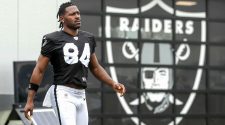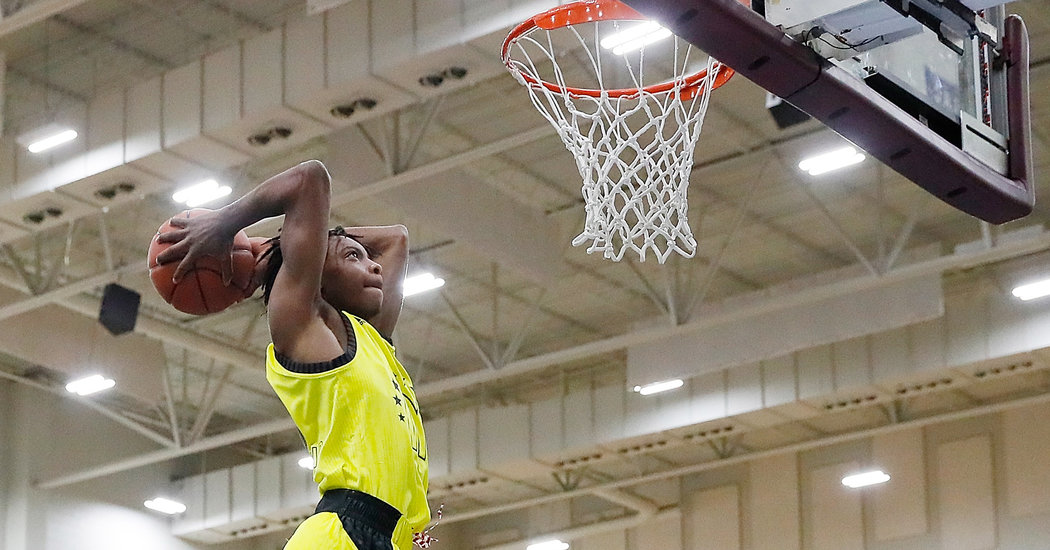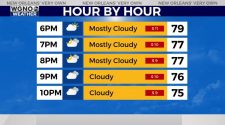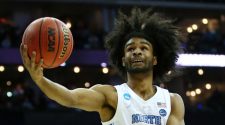The top three players in this year’s N.B.A. draft have been discussed so much that most people don’t even need their last names: Zion, Ja and R.J. will do. The words “three-player draft” have been bandied about ad nauseam.
So what happens when you’re the fourth player in a three-player draft?
Darius Garland, a sharpshooting point guard out of Vanderbilt, is likely to find out. That is, he will if his skyrocketing draft stock doesn’t launch him into that vaunted top-three.
The expectation heading into Thursday’s draft at Barclays Center is that the New Orleans Pelicans will take Duke’s Zion Williamson at No. 1, the Memphis Grizzlies, who plan to trade Mike Conley to the Utah Jazz, will take Murray State’s Ja Morant at No. 2, and the Knicks, despite some last-minute chatter about alternative options, will take Duke’s R.J. Barrett at No. 3.
Not so fast.
As Barrett sat at the Grand Hyatt in New York on Wednesday, answering at least eight questions about the Knicks, Garland was on a court working out for the team.
“It’s going to drive me to another level,” Garland told the reporters, adding that he believes the only reason he wasn’t in the conversation all along was the time he missed last season with a knee injury.
The 6-foot-3 Garland may have a point. He played just five games for Vanderbilt as a result of a meniscus injury in his left knee that required surgery, but in those five games he went 11 of 23 on 3-pointers. And when you consider his size, his wizard-like ball-handling, and his shooting range that starts just inside the half-court line, it’s easy to compare him to a pair of 6-foot-3 point guards: Stephen Curry and Damian Lillard.
Garland, 19, doesn’t have Curry’s N.C.A.A. tournament heroics, or Lillard’s four-year résumé of steady progress, but there are enough similarities that his falling outside the top group of picks could eventually look just as bad as it does now for those All-Stars.
Some, including ESPN’s Jay Bilas, believed there were good players to be had in 2009, but that Oklahoma’s Blake Griffin was the only sure thing. Curry had his fans, though. Mike D’Antoni, the coach of the Knicks at the time, seemed to know exactly what he’d missed out on when Golden State used the No. 7 pick on Curry, one spot before the Knicks drafted Jordan Hill.
“To be honest, probably, I’d be lying if I said no,” D’Antoni said when asked if he was upset that the Knicks could not draft Curry. Perhaps considering how Hill would view that statement, D’Antoni added, “It would probably be better if I lied to you.”
In 2012, the big knock on Lillard was that he had played for Weber State and might wilt against stiffer competition. He ended up being selected by Portland with the No. 6 pick.
“I can’t control what people believe or what people say,” Lillard told The Oregonian at the time. “But I know I belong here. I know I can play at this level.”
Garland, the son of Winston Garland, a point guard who played seven seasons in the N.B.A., also is not lacking for confidence. He would not even concede that moving up to No. 3 would match his ability, as he considered himself worthy of Memphis at No. 2.
“I’m a confident guy,” he said. “I’m not going to just say someone is better than me.”
The teams with the top four picks — Pelicans, Grizzlies, Knicks and the Pelicans again at No. 4 because of the pending Anthony Davis trade with the Los Angeles Lakers — have until Thursday night to figure out if Garland’s self-assessment is right.
The Case for the Other Guys
The Knicks should be the first team to tell people that getting the fourth player in a “three-player” draft can work out fine. That’s what happened to them in the 2015 draft, which was believed to be top-heavy with Kentucky’s Karl-Anthony Towns, Ohio State’s D’Angelo Russell and Duke’s Jahlil Okafor.
At No. 4, the Knicks selected a little-known Latvian named Kristaps Porzingis, who was listed in draft guides as being 6 feet 11 inches tall. In reality, Porzingis was 7-foot-3 and became an All-Star in 2017-18 before tearing his anterior cruciate ligament.
Things ended poorly between the Knicks and Porzingis, with the affectionately nicknamed Unicorn being traded to Dallas while he was rehabbing his knee. Still, it would be hard to say he hasn’t outplayed a “sure thing” like Okafor; other than last season, he was far superior to Russell as well. Thus far the most productive picks in that draft class have been Nos. 1 (Towns), 11 (Myles Turner), 32 (Montrezl Harrell), 6 (Willie Cauley-Stein) and 27 (Larry Nance Jr.).
There is no perfect basketball statistic to encapsulate a player’s worth, but Basketball Reference’s win shares have the No. 4 pick as the top player in five drafts: 1966 (Lou Hudson), 1975 (Alvan Adams), 1991 (Dikembe Mutombo), 2004 (Chris Paul) and 2008 (Russell Westbrook). And four other No. 4 picks (Byron Scott, Glen Rice, Rasheed Wallace and Antawn Jamison) proved to be more valuable than the three players drafted ahead of them, even if they weren’t the most valuable members of their draft classes.
Who Else Is There?
Beyond the top-three and Garland, the draft has plenty of interesting players. Texas Tech’s Jarrett Culver could be a huge asset on both ends of the court. Virginia’s De’Andre Hunter and Washington’s Matisse Thybulle could be defensive stars, Texas’s Jaxson Hayes will wow people with his dunks, and there are a pair of no-conscience shooters in Kentucky’s Tyler Herro and North Carolina’s Cameron Johnson. The draft has the son of Manute Bol (Oregon’s Bol Bol), the nephew of Dikembe Mutombo (Florida State’s Mfiondu Kabengele) and the cousin of Shai Gilgeous-Alexander (Nickeil Alexander-Walker).
Duke, North Carolina and Kentucky could each produce three first-round picks, and Virginia and Gonzaga could each produce two.
The most overarching theme of the draft, though, is how much this year’s player pool reflects the growing influence of the international game. Canada has a chance to beat France’s record of five players drafted from a country other than the United States in a single year, and the N.B.A.’s Basketball Without Borders program has a chance to top its best showing of six players drafted, a feat it has accomplished three times.
And in the biggest development for international basketball, Gonzaga’s Rui Hachimura, whose parents are Japanese and Beninese, is expected to make history as the first player born in Japan to be drafted.
















